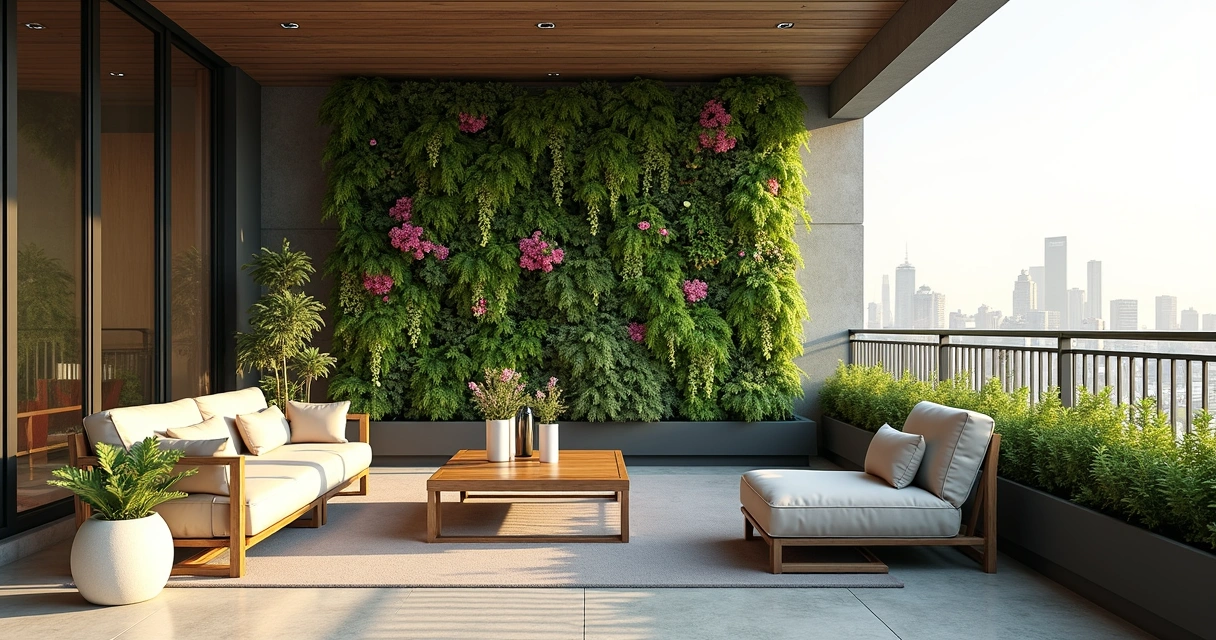Imagine standing in your apartment, gazing at a once-empty wall now bursting with lush greens and patterns of light. That’s the feeling a vertical garden can bring into everyday life—whether in a small flat, a dynamic office lobby, or even a restaurant’s patio. Urban Oasis has seen firsthand how these living walls not only transform spaces but also change how people feel within them. Let’s unpack how to create your own, using a simple step-by-step process rooted in both practicality and inspiration.
Why green walls are thriving in cities
Green architecture is having a moment, and for good reason. Studies point out that the global vertical garden market will soar by over $600 million by 2028, due to sustainable building practices and demand for urban greenery (Technavio report). And by 2032, that same market may reach $2.4 billion, all fueled by people seeking visually striking, energy-saving buildings (Allied Market Research). This growth is far from just a trend. Green walls are now hallmarks of sustainable design.
But what really makes green walls so compelling? In short—they turn overlooked spaces into sources of beauty, energy savings, and cleaner air. They’re not new, but thanks to evolving technology (think smart irrigation and hydroponics), anyone can bring one into their home or business as detailed by green.org.
Bring a forgotten wall to life.
The 7 steps to crafting your vertical green sanctuary
1. Define your space and purpose
Before picking up a trowel, pause. Look at the spot you want to transform. Is it inside or outside? Bathed in sunlight or cool and shady most of the day? Maybe it’s a kitchen that needs fresh herbs within reach, or a balcony that could use a splash of green privacy.
- Residential: Living rooms, balconies, kitchens.
- Commercial: Restaurant terraces, hotel lobbies, office reception walls.
- Small spaces: Entry corridors, bathroom walls, indoor partitions.
Choosing the right location matters. If the spot is outdoors, consider wind and weather. Indoors, think about temperature fluctuations near windows or air conditioning units.
2. Select the garden type
Most vertical gardens fall into a few clear categories. There’s no universal right choice; the answer lies in your purpose, maintenance appetite, and space size.
- Pocket systems: Fabric or felt pouches to tuck in each plant. Low-profile, can be DIY-friendly, but might dry out quickly.
- Modular panels: Pre-fabricated panels with built-in irrigation. Ideal for larger walls and commercial settings—these can be expanded or rearranged easily.
- Treillage and cables: Climbing plants grow on wire grids or metal frames, creating a gorgeous screen of foliage. Works well with fast climbers like ivy or jasmine.
- Hydroponic or aeroponic systems: Soil-free, ultra-modern, great for tech-savvy users and efficient water use. Now commonly seen in offices or new builds, as advancements bring prices down (emerging technologies in vertical gardening).
At Urban Oasis, we’ve noticed panels are often chosen for their clean lines and easy expansion, while pocket systems win out for creative, informal arrangements.
 3. Frame and support—structure matters
3. Frame and support—structure matters
The backbone of the living wall is, well, its backbone. For pocket or panel systems, choose rot-proof materials: galvanized steel, treated wood, or robust plastic. Attach to the wall using brackets that leave a small gap between the living wall and your home surface—this airflow prevents mold and moisture buildup.
If you’re a renter, or simply want something non-permanent, freestanding frames and movable panels can be game-changers. Just make sure your structure can support the water weight of plants and substrate.
4. Select the right plants for your situation
Plant choice can’t be an afterthought. Your space’s lighting—and let’s be honest, your willingness to care for plants—should guide the list.
- Deep shade: Ferns, philodendrons, pothos. These thrive where sunlight barely lands.
- Bright indirect or filtered sun: Peperomia, peace lily, spider plant.
- Full sun (outdoors): Succulents like sedums, some herbs (rosemary, thyme), lavender.
- Commercial/high-traffic: Durable picks like snake plants, zz-plant, or certain grasses for resilience.
If in doubt, start with a “mixed” approach: pair groundcovers with trailing vines and add a few showy foliage plants for a wild, lived-in vibe. According to studies shared on ResearchGate, thoughtful plant selection prevents disease, reduces maintenance, and maximizes benefits like air filtration.
Pick plants for your wall, not just your wish list.
5. Install the irrigation system
Here’s where a lot of people hesitate—but it doesn’t have to be complicated. The two usual routes:
- Manual watering: Perfect for smaller or indoor walls. Use a long-spout watering can or gentle spray bottle. You’ll need to water every few days, more often in heated or air-conditioned rooms.
- Automatic irrigation: Drip lines or wick systems carry water straight to plant roots, often using timers. Modern systems can be nearly invisible, tucked behind panels or inside frames. This is especially helpful for busy commercial spaces or vacation homes.
Technologies such as smart sensors and automated app-based controls, as highlighted in this article on the evolution of green wall tech, mean you can set and forget much of the work—just keeping an eye on tank levels or filter changes.
6. Plant your living wall
Now, the fun part. Arrange plants according to their water and light needs—group similar varieties together. Tightly packed arrangements create that plush, carpet-like look. For a more organic style, stagger heights, let vines trail, and tuck in miniature ferns or moss for an extra dose of green.
Water all plants well, then stand back. Your new wall might not fill in instantly. In a month or two, you’ll see foliage knit together, almost like it was always there.
7. Maintain, tweak, and enjoy
All gardens need a little love. Vertical plantings do best with regular trims—nothing fancy, just a touch here and there to keep growth in check. Watch for signs of over- or under-watering: yellow leaves, root rot, crispy edges.
- Feeding: Use a diluted, balanced fertilizer every 4-6 weeks, especially for heavy feeders like ferns and tropicals.
- Pest management: Stressed plants attract pests—catch problems early.
- Replanting: Occasionally swap out struggling plants for fresh specimens. This keeps your green wall lush and healthy.
Small adjustments, lasting impact.
Decorating with living walls: beyond the basics
Besides the clear benefits—lower temperatures, fresh air, less noise—vertical gardens simply transform spaces visually. They make bland corners stand out and can set the entire mood for a room or outdoor area.
Design inspiration ranges from bold, uniform patterns (like stripes of contrasting greens) to loose, naturalistic cascades. Urban Oasis often combines vertical gardens with integrated lighting to highlight textures at night, or builds patio seating into the base for immersive relaxation. The effect?
A living wall isn’t just décor—it’s atmosphere.
 Fresh design ideas for modern architecture
Fresh design ideas for modern architecture
- Office dividers: Swap boring glass screens for living partitions, providing privacy and sound absorption.
- Restaurant facades: Green walls draw in pedestrians and create an inviting entryway.
- Bathroom spas: Use moisture-loving plants to create a natural sanctuary—even in spaces that get wet.
- Small apartments: Try a freestanding structure that doubles as both storage and plant display.
Research shows that these approaches not only boost moods but can help regulate temperatures and even dampen noise, directly tying into lower energy costs (as explored in vertical garden research).
 Adding sustainability and savings
Adding sustainability and savings
Jardim vertical systems are more than decoration. They lower ambient temperatures in hot months, insulate in winter, and filter out dust and chemical pollutants. Less heat, less noise, potentially lower utility bills. These contributions to sustainable urban life mean vertical gardens are not just a visual treat but part of a healthier living environment (see the growth of energy-efficient green buildings for more). As a result, more architects and developers are bringing them into every kind of project.
Conclusion: Ready to green your space?
Bringing a vertical garden to life is about more than following a list—it’s a way to interact with your space, benefit your well-being, and make a real environmental difference. Whether it’s a cozy herb wall in your kitchen, a lush outdoor green backdrop for entertaining, or a bold statement piece for your business, the journey starts with one step (and a little curiosity).
Urban Oasis believes every space holds the potential to be something extraordinary with nature brought in. If you’re thinking about creating your own vibrant living wall, or want guidance on structure, plant choice, or long-term care, we’re ready to help you make it real. Reach out now—let’s make your vision grow.
Frequently asked questions about vertical gardens
What is a vertical garden?
A vertical garden, sometimes called a green wall or living wall, is a structure that allows plants to grow upright, usually attached to or supported against a wall. It can be indoors or outdoors and may use soil, felt, hydroponic, or aeroponic methods to support plant growth. They’re ideal for spaces where horizontal gardening isn’t possible or for creating a bold green feature with environmental benefits.
How to build a vertical garden?
To start, identify your wall or area and assess its light and exposure. Pick a structure—pocket, panel, or trellis. Make sure you have a sturdy frame and choose plants suited to your light and temperature conditions. Next, plan for watering, either manually or with a drip system. Install your plants, grouping them by similar needs, and remember to water well at first. Maintain your wall with regular checks for watering, feeding, and pest management. If unsure, consult specialists like Urban Oasis for support.
Which plants are best for vertical gardens?
The best plants depend on light and location. Shade-tolerant species like ferns, philodendrons, and pothos work well indoors or in low-light areas. For sunny spots, try succulents, herbs, or grasses. Commercial or busy environments benefit from hardy selections like snake plants and zz-plants. Always check that roots aren’t too aggressive and that water needs align across your chosen species.
How much does a vertical garden cost?
Costs vary widely based on size, garden type, and level of automation. A DIY pocket or trellis garden for a small space can be affordable, with modest investment in materials and plants. Ready-made modular panels or hydroponic systems can become more expensive, especially for large professional installations. There are ongoing costs—like nutrients or replacement plants—but overall, they are comparable to maintaining any garden. For exact costs, it’s best to discuss your idea with experts who can tailor a plan to your budget.
Is it worth it to make one?
For many people, the benefits—better air, cooling, privacy, unique décor—easily offset the initial effort or expense. Besides aesthetics, vertical gardens may reduce noise, purify indoor air, and help support local biodiversity in urban settings. If you’ve got the wall space and a bit of patience, it’s a creative, rewarding project. And with recent innovations, green walls are more accessible than ever. Many Urban Oasis clients say living with a green wall has changed how they feel about their spaces.


 3. Frame and support—structure matters
3. Frame and support—structure matters Fresh design ideas for modern architecture
Fresh design ideas for modern architecture Adding sustainability and savings
Adding sustainability and savings

